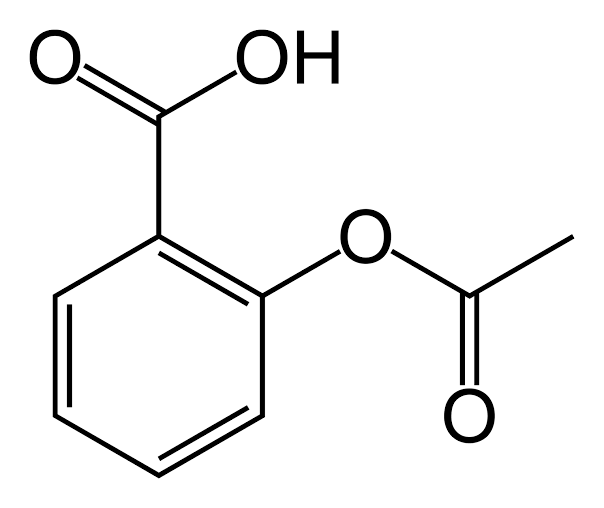
Acetylsalicylic Acid (ASA) is the chemical name of Aspirin, which is widely used worldwide. Aspirin Formula remains one of the oldest and most popular forms of the drug, which has common usage as an antipyretic and antiinflammatory. The Aspirin Formula will be discussed in greater detail below.
What is Aspirin
Aspirin, also known as acetylsalicylic acid, is a common generic medication used to address a range of ailments such as pain, fever, inflammation, and heart attacks. Its anti-inflammatory, anti-coagulatory, fever-reducing, and pain-relieving properties make it a frequently prescribed option. These effects are attributed to its main component - acetylsalicylic acid - which has the molecular formula C9H8O4. Although Aspirin falls under the category of NSAIDs (Nonsteroidal anti-inflammatory drugs), it can interfere with platelet functioning. Therefore, it is not recommended during pregnancy or given to children with infections. When taken in high doses, Aspirin may lead to side effects such as ringing in the ears, Reye syndrome, nausea, upset stomach, and headache. This compound was first synthesized by chemist Charles Frederic Gerhardt in 1853 using sodium salicylate and acetyl chloride. It quickly gained popularity and Bayer - a drug and dye company - began mass-producing it under the brand Aspirin. However, its fame diminished after other drugs like paracetamol and ibuprofen were developed in 1962.The formula of Acetylsalicylic Acid
 A French chemist named Charles Frédéric Gerhardt synthesized Aspirin for the first time in 1853. Like other compounds, Acetylsalicylic Acid does not occur naturally in nature.
A French chemist named Charles Frédéric Gerhardt synthesized Aspirin for the first time in 1853. Like other compounds, Acetylsalicylic Acid does not occur naturally in nature.
Also Check - Sugar Formula
Ocurrance
A French chemist named Charles Frédéric Gerhardt synthesized Aspirin for the first time in 1853, just like other compounds. Acetylsalicylic Acid also does not occur naturally in nature.Physical Properties of Aspirin
- 180.16 g/mol is its molar mass.
- 136°C is its melting point.
- 140°C is its boiling point.
- Water dissolves it.
- 1 liter of water can dissolve 3 grams of Aspirin.
- At room temperature, it is a white crystalline solid.
- In nature, it is weakly acidic.
- Its acid dissociation constant is 3.5 at 25 °C.
- The density of this material is 1.40g.cm−31.40g.cm−31.40 g.cm^{-3}.
Also Check - Butan 1 ol Formula
Chemical Properties of Aspirin
- When it comes in contact with moist air, it gets hydrolyzed.
- Although it is stable in dry air, it readily decomposes in a solution of ammonium acetate, carbonates, citrates, or alkali metal hydroxides.
- In its powdered form, it can be explosive.
- It has anti-inflammatory, anticoagulant, and analgesic properties.
Synthesis of Acetylsalicylic Acid
The action of salicylic acid on acetic anhydride synthesizes aspirin. Salicylic acid and acetic anhydride undergo an esterification reaction. When salicylic acid reacts with acetic anhydride, its hydroxyl group converts into an ester group, resulting in aspirin and acetic acid. Sulfuric acid or phosphoric acid act as catalysts.Also Check - Camphor Formula
Uses of Acetylsalicylic Acid/Aspirin
The following are some of the medical uses of acetylsalicylic acid.- Acute pain can be relieved with this analgesic.
- The herb is highly effective against muscle pain, bloating, skin irritation, and gastric distention.
- Migraines can also be treated with it.
- Cluster headaches can be effectively treated with it.
- Fever is treated with it.
- Inflammation is treated with it because it is anti-inflammatory.
- Those parts of the heart which have been attacked can be treated with it.
- Following surgeries such as PCIs, aspirin is recommended.
- Cancer risks are reduced by it.
Safety Hazards
At room temperature, aspirin will remain stable. However, keep it dry to prevent its hydrolysis. If you continue taking it for a long period of time, it can result in gastritis and ulceration. It is also incompatible with strong acids and bases, strong oxidizing agents, and strong oxidizing agents.Aspirin Formula FAQs
What is the chemical formula of aspirin?
The chemical formula of aspirin is C9H8O4.
What is the primary use of aspirin as a medication?
Aspirin is commonly used as a pain reliever (analgesic), fever reducer (antipyretic), and anti-inflammatory medication.
Is aspirin safe for everyone to take?
Aspirin should be used with caution, and a doctor's advice should be sought, especially for individuals with bleeding disorders, allergies to aspirin, or stomach ulcers.
How does aspirin work to reduce pain and inflammation?
Aspirin works by inhibiting the production of prostaglandins, which are chemicals that promote pain, fever, and inflammation in the body.
Are there any potential side effects of aspirin use?
Yes, common side effects of aspirin may include stomach irritation, ulcers, and an increased risk of bleeding. It's important to use aspirin as directed by a healthcare professional.
🔥 Trending Blogs
Talk to a counsellorHave doubts? Our support team will be happy to assist you!

Free Learning Resources
PW Books
Notes (Class 10-12)
PW Study Materials
Notes (Class 6-9)
Ncert Solutions
Govt Exams
Class 6th to 12th Online Courses
Govt Job Exams Courses
UPSC Coaching
Defence Exam Coaching
Gate Exam Coaching
Other Exams
Know about Physics Wallah
Physics Wallah is an Indian edtech platform that provides accessible & comprehensive learning experiences to students from Class 6th to postgraduate level. We also provide extensive NCERT solutions, sample paper, NEET, JEE Mains, BITSAT previous year papers & more such resources to students. Physics Wallah also caters to over 3.5 million registered students and over 78 lakh+ Youtube subscribers with 4.8 rating on its app.
We Stand Out because
We provide students with intensive courses with India’s qualified & experienced faculties & mentors. PW strives to make the learning experience comprehensive and accessible for students of all sections of society. We believe in empowering every single student who couldn't dream of a good career in engineering and medical field earlier.
Our Key Focus Areas
Physics Wallah's main focus is to make the learning experience as economical as possible for all students. With our affordable courses like Lakshya, Udaan and Arjuna and many others, we have been able to provide a platform for lakhs of aspirants. From providing Chemistry, Maths, Physics formula to giving e-books of eminent authors like RD Sharma, RS Aggarwal and Lakhmir Singh, PW focuses on every single student's need for preparation.
What Makes Us Different
Physics Wallah strives to develop a comprehensive pedagogical structure for students, where they get a state-of-the-art learning experience with study material and resources. Apart from catering students preparing for JEE Mains and NEET, PW also provides study material for each state board like Uttar Pradesh, Bihar, and others
Copyright © 2025 Physicswallah Limited All rights reserved.
Get App









